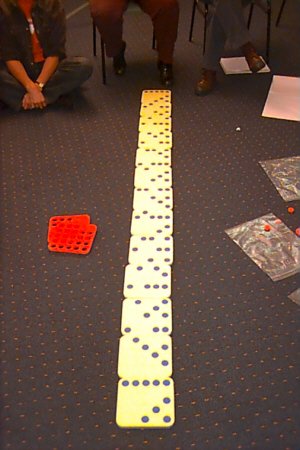 |
Vicky's Problem

Years 3 - 6 |
Summary
As part of Changing Places professional development, organised by the Tasmanian Aboriginal Education Unit, teachers were exploring Poly Plug. The framework of the workshop series was Learning to Work Like a Mathematician (or Working Mathematically) and that process is driven by questions and the teaching craft that interests the learner in them. Vicky posed the question below to her group and as the investigation grew other teachers became interested, contributing their Poly Plug and helping with the investigation. The group's work shows us how the same question can become a whole class investigation.
Materials
- Several sets of Poly Plug
Acknowledgement
Vicky Nicholson, Aboriginal Education Unit, Tasmania with assistance from
- Jaye Clair, Debbie Clifford, Joc McConnell ... Margate Homework Centre
- Sally Oakford, Liz Hall ... East Devonport Primary School
- Bev Hearps, Becky Murfett ... Penguin Primary School
|

|
Procedure

Suppose we turn over the top row of plugs to make them blue. Now...
- ...down the right hand column we count by 2s and turn over plugs
- ...down the column next to that we count by 3s and turn plugs over
- ...down the next one by 4s, the next by 5s and the next by 6s.
How many rows will it be before we get the first five in a row back again?
|
 |

Now this diagonal line might be a clue. We could keep it going and keep an eye on what happens in the other columns.
Mmm ... that means we have to put more boards in to keep the top blue line going.
Does that mean we are looking for when we get ten in a row ... or even fifteen in a row ... back again?
|
|
|
Content
- counting
- group (or skip) counting
- mathematical conversation
- multiples, factors & primes
- multiplication
- number line - ordering, operations
- operations - whole number
- pattern generalisation
- pattern interpretation
- pattern recognition
- recording - written
- times tables
- visual and kinaesthetic representation of number
- Venn diagrams
|

This doesn't look like such a good idea. Keeping that diagonal going means more boards along the top and getting all those back in one row seems to get further and further away.
Let's go back to the original problem and just keep on building until we get the five in a row to appear again.
We did it!!
It takes ___ rows before the five in a row comes back!
|

|
Step back a minute and take a deep breath. There is more hear than you are likely to see from 'this end'. Imagine yourself standing near the red boards in the photo, so the row is going across your tummy. Do you notice anything?
- There appears to be symmetry in the pattern.
- What would happen if this picture was recorded as dots on parallel number lines?
- Mmm, that could be a link to the Maths300 lesson Colour Spots on a Number Line.
To round off the investigation, encourage students to prepare a report. A digital camera could be useful if the report was to be in the form of a poster or slide show. The report might also include Venn Diagrams showing elements in the counting by 2s, 3s and 5s sets (say) and how they intersect. Calculating Changes Members can find more on this in the activity Amazing Venn Diagrams.
Extensions
- What happens if we begin with the right hand column counting by 1s.
- Try the same problem using parallel number lines.
- The blue plugs in each column are counting patterns - 2s, 3s, 4s, 5s, 6s.
How do these numbers connect with the number of rows before return (which is 60)?
- Suppose we start with a simpler problem, say two blue plugs only in the first row, and count by 2s and 3s. How many rows until two blues return? Why?
- What happens if we start with three in the top row and count by 2s, 3s and 4s? How many rows until three blues return?
- What happens if we start with 10 in the row and count by 2s, 3s, 4s, ... 11s? How many rows until return?
- Task 123, Bob's Buttons, investigates a related problem based on counting by 4s and 5s.
- Maths300 Lesson 117, Colour Spots on a Number Line, explores patterns on a number line.
- Maths300 Lesson 146, Division Boxes, explores divisibility tests and relates to the challenge above of starting with 10 blue. It includes software support.
- Maths300 Lesson 181, Natalie's LCM Task, is all about lowest common multiples. It includes software support.
- The NRICH web site has a neat, software-based extension of this activity which they call Poly Plug Pattern. It explores making patterns on an interactive Poly Plug grid and extending them to a larger grid.

Calculating Changes ... is a division of ... Mathematics Centre
|